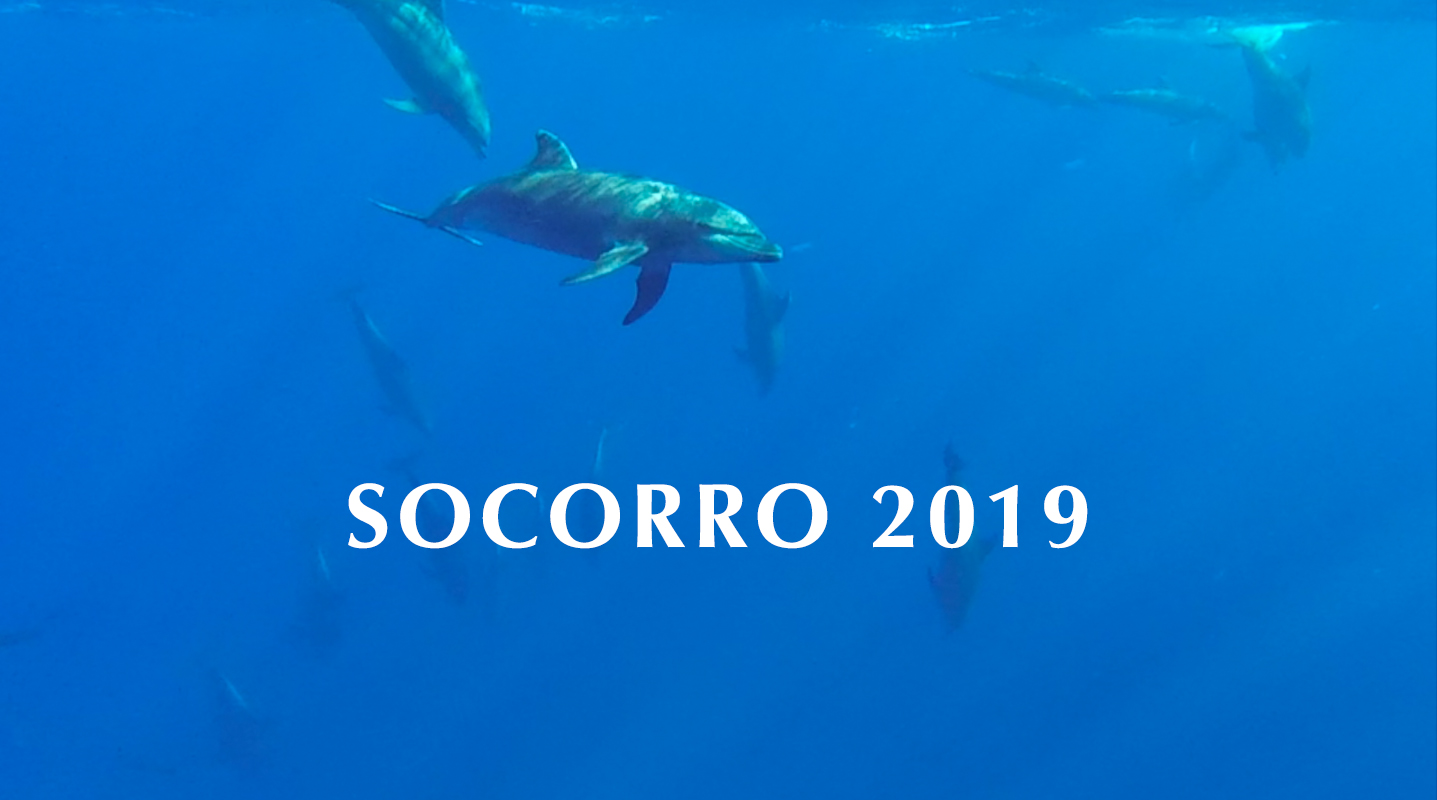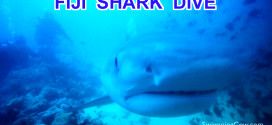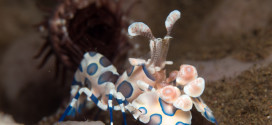The genesis to my Socorro trip was in a question.
“Where’s the best diving you’ve ever had, Ali?”
It was early evening. We were on the sun deck of the MV Black Manta floating somewhere in the Komodo Islands, Indonesia. Before us, the sun dipped slowly beneath the horizon, casting the last of its golden rays across the land and sea.
Ali considered the question.
“The Galapagos,” he said after a pause. “Oh! And Socorro! You have to go to Socorro.”
That was how I came to hear of the friendly giant mantas of the Pacific archipelago, the only place in the world where mantas are known to seek out human interaction. Several years later, three friends and I found ourselves flying in to Mexico from four corners of the world to start what would become the trip of a lifetime.

Roca Partida, Revillagigedo Archipelago
Socorro
Officially known as the Revillagigedo Archipelago, the Socorro Islands lie off the west coast of Mexico and consists of four islands. It’s a UNESCO World Heritage site and truly deserves its status as one of the best dive spots in the world. To get there, you fly in to Cabo (airport code: SJD) and jump on a liveaboard. The crossing takes approx. 24 hours and the seas can be rough so anti-seasick pills/patches are recommended. I didn’t find it to be that bad and didn’t need anything for the return trip but a number of divers complained of poor sleep throughout the trip. Definitely consider dramamine and the like to at least help you fall asleep through the rolling seas.
Diving the Boiler
Socorro is a paradise for diving with pelagics. We saw so many amazing schools of hammerheads, reams and reams of black and white tip reef sharks, silkies, and even the odd Galapagos shark. Amazing to be swimming with them, watching them move gracefully through the water. I could’ve done it all day long. Getting video footage of the sharks was another matter though – by nature, sharks tend to be very shy and scamper off when you give chase :( (see video below)
Though we’d had a number of magical moments on this trip, the dive of my life happened on the morning of our last dive day, when we returned to the famous dive site called “the Boiler”. We’d first made it out there on our first dive day, when two gigantic Chevron mantas (4.5 metres to 5 metres wingspan) played with us for the better part of an hour. The mantas in Socorro are unique in that they aren’t at all shy and in fact seem attracted to diver bubbles and would often swim right over you to catch some bubbles over their bellies. In the places I’ve dove, such as Raja Ampat, most mantas don’t display anywhere close to this level of interest in divers. To have found myself literally within an inch beneath the belly of a soaring oceanic manta, its wings gently swooping up and down as the two of you cruise through the blue – that in itself was enough of a memory to last a lifetime.
On the last dive day, however, the ocean had even bigger surprises in store for us. Shortly after descending to about 20 metres, we saw two mantas sweeping towards us. A fully thirty minutes melted away as we took turns flying and blowing bubbles for them. We were, as you can imagine, transfixed. I’ve seen a fair number of stellar things overland and underwater, but few compare to the thrill of having these beautiful creatures pass overhead, within an inch of your head, their massive bodies cruising like a tanker sailing through the seas.
And because we were so entranced by the mantas, it took us a while to notice a surprise visitor in our midst: a bottlenose dolphin. It appeared out of the blue (haha. Sorry, diver pun.) and was simply hovering amongst the divers. I only happened to look down, and there it was: barely a metre from my fins, in near-full vertical position and perfectly still, with that trademark dolphin smile on its snout. They tell you that bottlenose dolphins are highly intelligent, that they have the highest brain-to-body-weight ratio after humans in the world, but it was only when I found myself face to face with a wild dolphin that I was finally struck by the fact that this, right here, was a sentient and intelligent creature. It made no attempt to bob around or squeak (as dolphins do) to draw attention; it merely hovered there calmly, as if it just knew that this was enough, that we would eventually notice and, once we did, we would abandon our play time with the mantas and follow it instead. Which, of course, was exactly what we did.
Once it was sure it had our attention, it turned, as if to lead us away. Up until this point, I had never seen a dolphin up close – my only encounters had been from a distance while on boats or when I was taken to Ocean Park in Hong Kong as a child (I guess it comes as no surprise that nowadays I boycott parks that hold animals in captivity). Which is to say, I never realised how large dolphins can be! This surprise visitor was at least 2 metres/ almost 7 feet (later confirmed by dive guide). It was both an astounding and humbling discovery. Another surprise was the amount of scars and scratches on its back, which were bright and clear against the light of the sun overhead. (I later looked this up and apparently dolphins can be quite aggressive with one another and with smaller species of dolphins; most of what we saw were likely battle scars.)
Soon, our visitor was joined by another pair of dolphins and the trio kept on swimming as we followed. Alas, they were too fast for us clumsy humans and disappeared around the corner of the rock. Just as disappointment was setting in, something bloomed into vision. There, far beneath us in the deep blue, shadows of about a dozen dolphins emerged. They were still some distance away but the three original dolphins returned much closer to where we were, this time with three more of their pod. The six of them kept swimming towards us; they wanted to interact. At this point, I think I could be forgiven for thinking that we were narc’ed out of our minds, because all of a sudden, we had almost twenty dolphins within view, two mantas still circling us looking for more bubbles, and a Galapagos shark not far behind (though not at all interested in us. Boo.) It was the best sort of divers’ problem: where do you look?! I could not grow eyes fast enough for the scene before me.
Sadly, we were by now some 45+ minutes into our dive and we were left with 50 bars or less of air. It was time to ascend and leave this spectacular ocean show behind. But if there was any doubt that the dolphins were keen to interact, we needed no further proof than at our safety stop, where the pod of twenty dolphins ascended with us and checked us out near the surface as we floated about. One black manta even followed us all the way back to the Belle Amie and hung around as some of us went snorkelling with it. It was times like these that I was struck by the sad divide: that of the ocean world and the world of air, two worlds that rarely crossed, of which we are just brief guests.
Here’s a video I put together of the trip where you can see the dolphins accompanying us near the surface:
With the best memories properly chronicled, here’re a few more things for divers looking to plan a trip to Socorro:
Booking Your Liveaboard
Given its fame on the diving circuit, booking a berth on one of the Socorro liveaboards takes some planning. I’d recommend securing your slot 10-14 months out. There’s a range of vessels, from the basic to the luxurious. I booked a suite on the Nautilus Belle Amie (also known by its original and more hilarious name, “Where’s John”) and would thoroughly recommend this if you’re looking for a more comfortable passage with frills like a hot tub and don’t mind a big boat. Side note: it would have been nice to see some more environmentally-friendly practices onboard – the shampoos et all were not biodegradable onboard the Nautilus and and everything was given in small plastic bottles instead of being put in a big, refillable holder in the shower cubicle. If anyone knows of dive operators that do this in Socorro, please drop me a note!
Diving Conditions
As wonderful as Socorro may be, it’s not necessarily the easiest of dive trips. For the most part, our dives were easy and without any discernible current. But, as mentioned, the seas can be rough and its location out in the Pacific also means you can be exposed to some pretty strong currents, especially at Roca Partida. If you’re not used to diving in such conditions (think: the Komodos, the Galapagos) I’d definitely recommend holding off a trip to Socorro until you’re more comfortable navigating currents. If you are swept away by the current, follow the usual safety protocol: ascend, do your safety stop, deploy your SMB, then surface.
In terms of dive spots, we went to the Canyon and the Boiler at San Benedicto, Cabo Pearce at Socorro, and Roca Partida.

The Catan-like island of Socorro
Gear
Bring your most powerful fins. I brought my Mares Avanti Quattro Plus and had a good laugh when I got to the boat and saw that 90% of us had opted to bring the exact same fins. These are truly the best in the business. When we were kitted up in the panga about to go dive, we looked like a commercial for the Avanti Quattro Plus!
In terms of other gear, I wore a 7mm wetsuit and a 5mm hood and found this to be adequate in keeping me warm. Most divers had a similar kit. A few dove in drysuits, though they said they felt that wasn’t necessary. Bear in mind that my trip was in March and the water was generally about 24ºC/75ºF; temperatures do change throughout the dive season.
Diving Regulations
The marine reserve is doing great things but it’s also one of the strictest reserves I’ve been to. Starting from 2019, they’ve introduced a new rule where you are not allowed to dive in when you spot humpbacks (most likely to prevent people from chasing/scaring the whales). This is wonderful for the wildlife but it does dramatically cut your chances of actually seeing the famed humpbacks underwater. My group was lucky enough to catch a glimpse of a passing calf at the start of one dive but you’ll still have plenty of chances to see the whales from the boat decks. Just know that you are very unlikely to see whales whilst diving from here on out.
A number of new, less significant rules have also impacted a few other things. Eg. on the silky shark snorkel at night, you’re prohibited from using dive torches, which means you can’t really see much half the time.
Diver Safety
Lastly, a big shout out to the lovely, lovely crew of the Belle Amie, especially Capt. Graham and the dive guides – Filipé, Thiago, Martyn, Adrian, and Christian. Each brought their personalities with them (some, also their goofiness – ahem *Martyn* ahem) and the trip was made all the funner because of their sense of humour. The focus on safety onboard the ship was also wonderful. We were each given air horns and the Nautilus-developed GPS locator which were added to our BCDs. Though we obviously never hoped to have to use them, they certainly went some ways to assuring us that we were well covered on the safety front. All in all, this was a marquee trip, full of memories that I will carry with me for as long as I will live.

Final sunset on the Nautilus Belle Amie
 J.J. Pedersen let’s go see the world
J.J. Pedersen let’s go see the world



